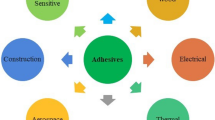Abstract
We have established that antistatic coatings based on EP-0010 putty and graphite have low adhesion to metal and breaking strength but are resistant to the action of an operating environment. The use of carbon black as a conducting additive increases 1.5–3 times the strength of free films obtained on the basis of the given epoxy composition as compared with graphite and decreases their mass losses in an operating environment. The adhesion of epoxy coatings based on the EP-0010 composition modified by carbon black is 2–2.5 times as great as that of coatings with a graphite filler. The use of a plasticizer based on epoxidated vegetable oil instead of an inert phthalate plasticizer in a carbon-containing epoxy composition is promising and, in the case of optimal content of the components, enables one to enhance significantly the physicomechanical characteristics of antistatic epoxy coatings and their resistance to the action of the operating environment.
Similar content being viewed by others
REFERENCES
Yu. O. Venhertsev, V. M. Hloba, and T. A. Martynyuk, “Methods of enhancement of the service reliability of steel tanks,” Naft. Gaz. Prom., No. 4, 47–48 (1996).
M. I. Finkel'shtein, Industrial Application of Epoxy Paintwork Materials [in Russian], Khimiya, Leningrad (1983).
H. Lee and K. Neville, Handbook on Epoxy Resins, McGraw-Hill, New York (1967).
GOST 28569-90. Means of Storing and Transportation of Light Oil. General Requirements for Rust Protection [in Russian], USSR State Committee on Standards, Moscow.
A. D. Eselev, D. Ya. Gusakova, and N. S. Kardash, “New anticorrosive epoxy materials for industrial engineering,” in: Sci. Tech. Abstr. Digest, Ser. IV: Anticorrosive Works in Civil Engineering [in Russian], Issue 5, NIITEKhIM, Moscow (1979), pp. 8–11.
A. S. Krasovitskii and A. A. Shevchenko, “Experience in the application of epoxy coatings for the protection of equipment for chemical water treatment,” in: Sci. Tech. Abstr. Digest, Ser. IV: Anticorrosive Works in Civil Engineering [in Russian], Issue 5, NIITEKhIM, Moscow (1979), pp. 13–14.
H. Vasicek and I. Bocek, A Paintwork Material Based on a Modified Epoxy Resin for Struggle against Static Electricity, CSSR Author Certificate No. 224316, C 09 D 5/24, C 09 D 3/58, Publ.July 1 (1984).
E. P. Mamunya, “Electrical and thermal conductivity of polymeric compositions with disperse fillers,” Ukr. Khim. Zh., 66, No.3, 55–58 (2000).
V. Piddubnyi, M. Voloshyn, B. Lavryshyn, and M. Yatsyshyn, “A study of composite materials based on F-2M fluoroplastic,” in: Abstracts of Papers of the I Symp. of the Chemical Commission of the Shevchenko Scientific Society, Theoretical Problems of Chemistry [in Ukrainian], Shevchenko Sci. Soc., Lviv (1993), p. 30.
E. F. Belen'kii and I. V. Riskin, Chemistry and Technology of Pigments [in Russian], Khimiya, Leningrad (1974).
DSTU 4219:2003. Steel Main Pipelines. General Requirements for Rust Protection [in Ukrainian], State Committee on Standards of Ukraine, Kiev (2003).
GOST 12020-80. Plastic Materials. Methods of Determination of the Resistance to the Action of Chemical Agents [in Russian], USSR State Committee on Standards, Moscow.
L. G. Plotkin, “Graphite-reinforced plastics,” in: Encyclopedia of Polymers [in Russian], Vol. 1, Sovetskaya Entsiklopediya, Moscow (1972), pp. 646–655.
Author information
Authors and Affiliations
Additional information
__________
Translated from Fizyko-Khimichna Mekhanika Materialiv, Vol. 41, No. 2, pp. 109–113, March–April, 2005.
Rights and permissions
About this article
Cite this article
Piddubnyi, V.K., Zin', I.M., Lavryshyn, B.M. et al. Effect of Carbon-Containing Conducting Fillers on the Properties of Epoxy Coatings. Mater Sci 41, 265–270 (2005). https://doi.org/10.1007/s11003-005-0160-4
Received:
Issue Date:
DOI: https://doi.org/10.1007/s11003-005-0160-4




